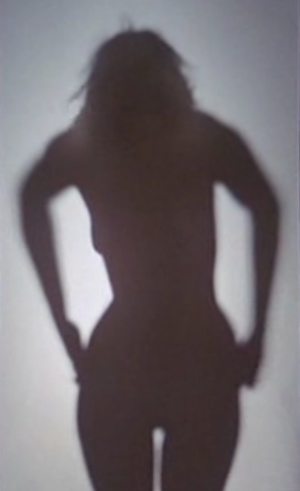2023-06-25
Brass In Pocket
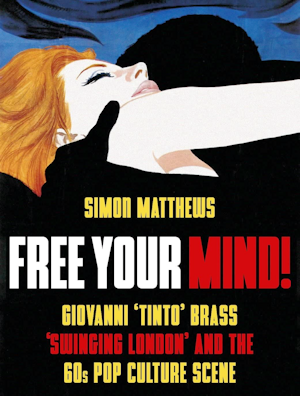
In 2017, I reviewed Simon Matthews’ Psychedelic Celluloid, which lists 120 films that all have something in common with Swinging London. This year (2023), Simon was so kind to send me a spiritual successor to his earlier work. Titled ‘Free Your Mind!’ it describes in great detail four films set in psychedelic London between 1967 and 1970 and made by the Italian movie legend Giovanni ‘Tinto’ Brass.
Cali-who?
Don’t try to hide the fact that you don’t know who Brass is. He was behind the infamous Caligula flick (1979) that we all pretend not to have seen. To Tinto’s defence, we need to add that the hardcore pornographic scenes it contains were added without his consent by the Penthouse producers.
Tinto Brass started as an experimental and avant-garde director, but just like the Polish film director Walerian Borowczyk, he stumbled into the light-erotica genre with movies such as All Ladies Do It, Paprika, and Frivolous Lola.
Pink Floyd fun fact #1: In 1976, Walerian Borowczyk made the film La Marge, described by some as art house erotica. One scene has Silvia Kristel doing her thing with the intro of Shine On You Crazy Diamond in the background. It has been rumoured that Pink Floyd has always refused a DVD release just because of that. Read More on this blog: La Marge.
But back to Giovanni Brass. After his studies as a lawyer (pushed by the family), he decided he wanted to become a photographer or filmmaker. In 1957, he went to Paris, where he joined the world-famous Cinémathèque Française as an unpaid worker. He managed to consult their Rolodex and was soon promoted to assistant director and producer of avant-garde documentaries.
These experimental films were not unlike John Latham's Speak, with images ‘juxtaposed in an absurd, violent, satirical, or sinister fashion’, writes Simon Matthews (P36).
Pink Floyd fun fact #2: John Latham's Speak (1962) was projected behind Pink Floyd at a Roundhouse gig. In 1967, the band attempted to make a soundtrack for the movie, but it was rejected by the artist. The improvisational piece, split across nine tracks, can be found on The Early Years box set.
Tinto Brass' reputation grew fast. Some of his work was censored by the Italian government, but some were promoted and sponsored by Umberto Eco.
It didn't take long to make a few take-the-money-and-run films. These had some success in Italy and Spain like the 1964 sci-fi comedy 'The Flying Saucer' (1964) and a spaghetti western called 'Yankee' (1966).
In 1966, he decided it was time to go to London for a pop-style swinging London movie.
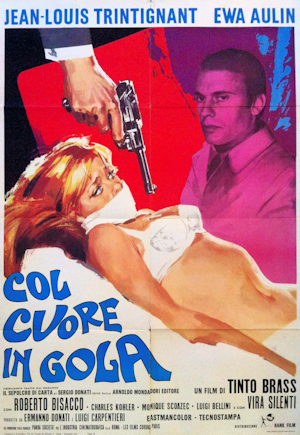
Murder She Wrote: Col Cuore In Gola
Col Cuore In Gola (CCIG) is also known as Dead Stop, Deadly Sweet, En cinquième vitesse, Escalation, Heart Beat, Heart in His Mouth, I Am What I Am, La séptima victima, and Le cœur aux lèvres. As usual for the German market, the distributors managed to grab a title completely out of the blue: Das Mädchen aus der Carnaby-Street, although that title isn’t that bad, for a change, and describes its mood pretty accurately.
Col Cuore In Gola is a pop art extravaganza with a flimsy story but a lot of swinging London. It came out in the same year as Michelangelo Antonioni’s Blow-Up and Two Weeks in September (French title: À coeur joie) by Serge Bourguignon with Brigitte Bardot.
Pink Floyd fun fact #3: the soundtrack of Two Weeks in September has two songs from Michel Magne sung by David Gilmour, from the band Jokers Wild, before he joined Pink Floyd.
For his movie, Tinto Brass managed to hire French film star Jean-Louis Trintignant and Brigitte Bardot lookalike Ewa Aulin (from Sweden). The story is even more incomprehensible than that of Blow-Up, but creating a logical storyline wasn’t something Brass was after.
It all starts with Jane (Ewa Aulin), who has to identify her father's body after he was killed in a car accident. Immediately after the mortuary's visit, she goes dancing in a groovy nightclub, the logical thing to do when your father has just been declared dead. That's where Bernard (Jean-Louis Trintignant) finds her looking at another dead man, a gangster boss who was just shot down. The gangster may have blackmailed and even killed her father, so the visit to the club was not that arbitrary after all.
Jane claims she didn’t shoot the criminal, and Bernard immediately believes her, because boobs and a pretty face. They flee from the scene, followed by mobsters, the police, and a dwarf(!), leaving a trail of dead bodies behind (9 in total, if I’m correct), not a very intelligent move if you want to keep a low profile.
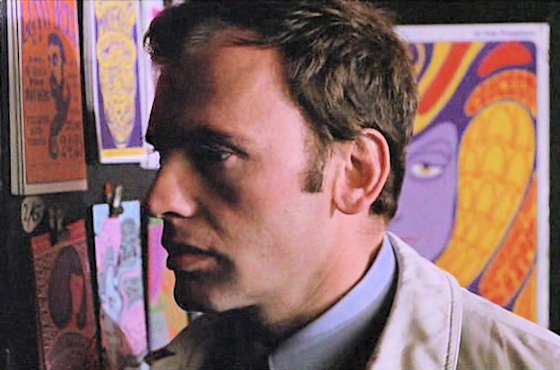
Running through London, they manage to do some shopping at Granny Takes A Trip, and they visit the Indica gallery from Barry Miles. Throughout the movie, references to underground counterculture and pop art can be seen, like International Times posters on a wall. The film often has a comic-strip feel, one scene even mimics the wacky Batman punches from the American TV series. Renowned comic book artist Guido Crepax also worked on this movie, by the way.
Iggy the Eskimo fun fact #1: This blog started in 2008 when a documentary was found that had Iggy The Eskimo visiting Granny Takes A Trip. Find more at this blog: IN Gear.


Ally Pally
The 12-minute finale of the film takes place at The 14 Hour Technicolor Dream Festival held at Alexandra Palace on April 29, 1967. Weirdly enough, this is something that is never mentioned in Pink Floyd biographies or Swinging London books.
Pink Floyd fun fact #4: The Technicolor Dream was to raise funds for the International Times legal defence fund and was organised on April 29, 1967. Pink Floyd appeared right at the end of the show, just as the sun was beginning to rise at around five o'clock in the morning (already the 30th of April 1967). According to Nick Mason, Syd was completely distanced from everything going on, ‘whether simply tripping or suffering from a more organic neural disturbance’.
Technicolo(u)r Overdrive
Simon Matthews gives a few reasons why the Tinto Brass film has been entirely forgotten when it comes to Ally Pally.
Already in 1968, the movie was reviewed by critics as a blatant Blow-Up rip-off, released while Col Cuore In Gola was still in the making. Both films have an erotic photo-shoot scene, although the one from Brass was shot earlier than the one from Antonioni. This doesn’t take away from the fact that Blow-Up is regarded as the ultimate Swinging London flick, with CCIG hiding in its shadow.
Tinto Brass used the technique of guerilla filmmaking, meaning that he placed his actors in real-life situations. In this case, the streets and parks of London. While the actors did their thing, people and tourists walked around, not realising that a movie was being shot in and around them. It was also a money saver, as he didn’t need to ask for permission to have a camera crew lurking around.

Pennies and Pounds
For the filming at Alexandra Palace, he did pay a great deal of money, and according to Simon Matthews, the funds of the Italian moviemaker probably saved the organisation from going bankrupt before it even started.
Aulin and Trintignan walk around in and between the crowd of The 14 Hour Technicolor Dream. We get some shots of an avant-garde dance troupe and Yoko Ono’s Cut Piece, but that’s about it.
Brass did miss a few things that would have made his film immortal, at least from a historian's perspective.
One: John Lennon and John Dunbar were there. They were caught by a camera team from the BBC and Peter Whitehead.
Pink Floyd fun fact #5: Peter Whitehead was the director of Tonite Let's All Make Love in London (1967), which had a short musical piece by Pink Floyd. In 1995, he published ‘London '66–'67’ an EP and film of Pink Floyd music, containing an alternative version of ‘Interstellar Overdrive’ and a previously unreleased track, ‘Nick's Boogie’.
Two: it has been rumoured that Andy Warhol was watching the event from his Rolls Royce, parked outside. The pop-art superstar didn’t have the guts to mingle with the mortals inside.
Three, and certainly not least: Brass didn’t grab the interstellar show Pink Floyd was doing at dawn.
Of course, Tinto Brass was shooting the end scenes of his movie at the Ally Pally. These scenes had to be perfect and couldn’t be repeated on another day. He probably didn’t have the time to chase celebrities or record rock bands.
Col Cuore In Gola is a roller coaster, fun while it lasts and rapidly forgotten afterwards.

Movie two: Nerosubianco
Tinto Brass made four Swinging London movies in total.
Nerosubianco (Attraction, Black on White) is Brass’ second summer of love film, starring Swedish actress Anita Sanders (as Barbara), who mainly played in Italian movies. It tells the story of an upper-class woman who starts daydreaming when she sees an attractive African American man (Terry Carter). Reality and dreams interconnect. The viewer has to guess what is real and what is fantasy.
The movie revolves primarily around the music of Freedom, who can be seen performing in several scenes. Freedom was a Procol Harum spin-off when two of its members were kicked out by Gary Brooker, just after A Whiter Shade Of Pale was released. Freedom evolved into a short-lived hard-rock band, but for this soundtrack, they used a more default psychedelic approach.
Just like in CCIG, a lot of scenes have been taken by candid cameras; the actors visit Hyde Park, Woburn Abbey, galleries, and shops, and witness underground happenings.
Iggy the Eskimo fun fact #2: Iggy visited the first Woburn Abbey festival, in 1967, where her picture was taken, perhaps by photographer Feri Lukas. More info on this blog: Iggy - another festival, another look.
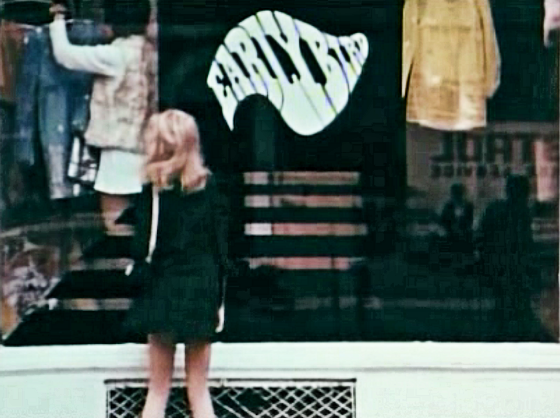
One scene has Barbara visiting The Roundhouse, where she watches a Mark Boyle light show, probably the only cinematographic evidence of his ‘Son et Lumière for Bodily Functions and Fluids’.
Pink Floyd fun fact #6: Mark Boyle, described by Mark Blake as the UFO’s in-house lighting wizard, had been a regular at Mike Leonard’s sound and light workshop at Hornsey College of Art (P68-69). Pink Floyd played The Roundhouse on October 15, 1966, for the International Times launch and lived at Leonard’s house for a while.
Nerosubianco, with its depiction of London during the summer of love, could be legitimately regarded as part of the cinematic canon of work associated with Pink Floyd and The Soft Machine, concludes Simon Matthews (P133-134).
It is a psychedelic trip with groovy music, cows on a couch, and a kaleidoscopic attack on your eyes and mind. The movie ends with the band Freedom running towards the horizon, in Beatles Help style, chased by the film crew.

Movie three: L’Urlo
Tinto Brass refused an offer to direct A Clockwork Orange (more or less, it’s a complicated story) and asked would-be erotic kitten Tina Aumont (as Anita) to star in L’Urlo (The Howl, The Shriek). The shooting began in September 1968.
A tagline description of this film could be: Nude hippies chased by the police.
One of the first scenes shows Anita taking a shower after she has been arrested for participating in a Grosvenor Square demonstration against the Vietnam War. It is suggested that the police raped her. She runs away on her wedding day and ends up in a hotel that seems to be an elaborate sex dungeon. Spike Hawkins' Three Army Poem is shown for less than a second.
Syd Barrett fun fact #1: Rob Chapman, author of the Syd Barrett biography A Very Irregular Head, found out that Beatnik and poet Spike Hawkins was an acquaintance of Syd Barrett. He was interviewing Pete Brown for his book, and when the interview was over, he remarked that some Barrett lyrics had a distinct Spike Hawkins style. At that point, Pete Brown remarked: "I think Spike Hawkins knew Syd Barrett." The two artists not only knew but also met, each other on different occasions, although it was probably more a Mandrax haze that tied them together than the urge to produce some art.
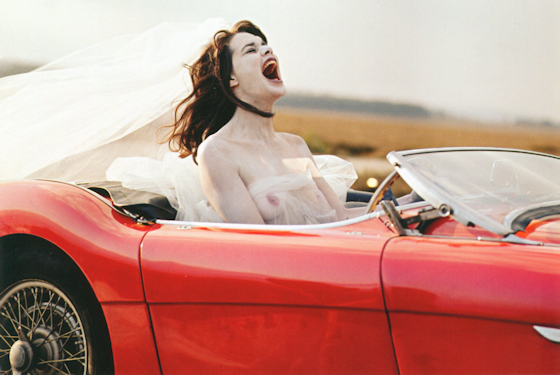
Anita walks into a tunnel where we have Pete Brown and his Battered Ornaments performing in front of a bunch of nude hippies (but without the actual sound). Anita ends up on an island with a toothless lion and flees, once again, but now in a sports car. She crashes the car. She dies. The End.
Pink Floyd fun fact #7: Pete Brown and his Battered Ornaments were managed by Peter Jenner and Andrew King from Blackhill Enterprises. They also managed the early Floyd and Syd Barrett. Read more on this blog: An innerview with Peter Jenner.
A cool description of the film can be found on IMDB by NateManD.
Take some Fellini, add some Jodorowsky/Arrabal and a little tablespoon of Godard for an extra kick, stir and you got yourself "L'Urlo". One crazy psychedelic, surrealist anti-war art orgy. A bus is lit on fire! Hippies are chased by riot cops. There's stock footage of Vietnam and other wars with a machine gun showdown! S&M, slapstick sexuality, a man's pursuit of a beautiful lady... abstract art and nudity galore! (.../…) This film is pure punk rock before punk even existed.
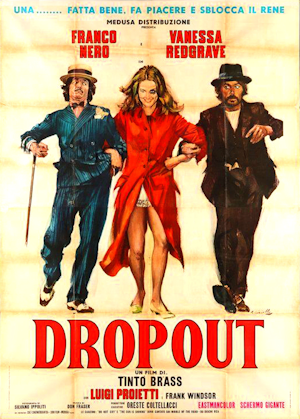
Movie four: Dropout
L’Urlo had big problems being distributed, it was censored in Italy, and several cuts had to be made, with less and less nudity. On a private screening, Brass showed his cut to Vanessa Redgrave, and Franco Nero. They were impressed.
After some work on Barbarella Goes Down, a movie that would never see the light of day, Brass started Dropout, a film that was self-financed and shot on 16 mm to cut expenses. The plot is a variation on Nerosubianco and LUrlo, with a woman (Vanessa Redgrave as Mary) meeting a man (Franco Nero as Bruno) who shows her an alternative way of life by meeting some society dropouts: unemployed, drug addicts, drag queens, alcoholics, and anarchists.
While Mary and Bruno run around London (a recurring theme for Brass, apparently), sometimes interrupted by the police (another recurring theme), they end up at the SPACE gallery at St Katharine Docks. There, some sculptures from the Dutch sculptor Herman Makkink can be seen, including the Rocking Machine, which is used as an infamous murder weapon in Kubrick’s A Clockwork Orange. Although Brass was involved in an early version of A Clockwork Orange, it is probably just a coincidence that both movies have the same sculpture.
Scottish band Middle of the Road recorded two songs for Dropout before their rise to fame had begun. The Sun Is Shining sounds like a leftover from when the band was a Latin American outfit named Las Caracas. The second song, Do Not Cry, is an ode to Sacco and Vanzetti and miles away from the bubble gum pop that made them world famous.
Pink Floyd fun fact #8: Pink Floyd and The Soft Machine would use the warehouses at St. Katharine Docks for rehearsals (P203).
While the first three films can be easily obtained in these days of internet piracy, Dropout only exists in a bad copy, taken from Italian television, and in the hands of collectors only.

Conclusion
I must say I wasn't that interested at first in a biography of an Italian filmmaker who happened to do a few movies in London in the sixties. But Simon Matthews weaves a web around the story of Tinto Brass, adding dozens of links with people and organisations from the underground, the avant-garde, the rock scene, and the movie world. (Just like Julian Palacios did in Dark Globe, but around Syd Barrett and the early Floyd.)
In that aspect, it is much more than a Tinto Brass biography. Just like the title predicts, it gives an overview of ‘swinging London and the 60s pop culture scene’, through the cinematographic lens of Giovanni Brass.
People who have read some of my reviews know that I am a sucker for footnotes (Men On The Border is mentioned in one of those) and that I can’t resist a bulky index. Free Your Mind! has a 23-page index, making it a joy to jump from page to page.
Free Your Mind! is the kind of book I like to read.
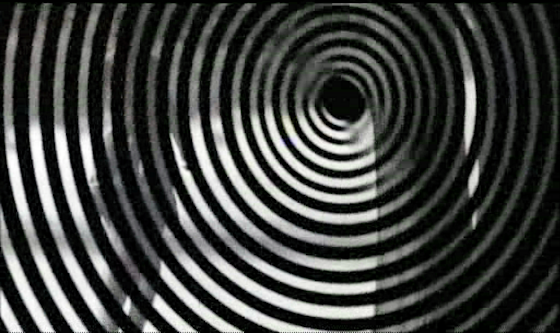
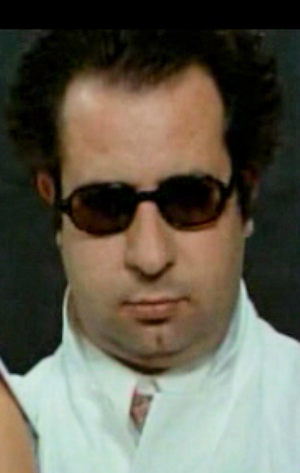
Anoraky Epilogue
Col Cuore In Gola and Nerosubianco are late sixties pop-art extravaganzas, with all the joys but also the flaws of the underground and avant-garde movies of that era. L’Urlo is fun, throwing in some boobs every ten minutes, but from a historical perspective, it's less interesting.
Luckily, there is Matthews’ book to guide the uninitiated viewer through the many relics of Swinging London that show up in these Tinto Brass films, and there are a lot.
Matthews, Simon: Free Your Mind! Giovanni 'Tinto' Brass 'Swinging London' and the 60s Pop Culture Scene, Oldcastle Books, Harpenden, UK, 2023, 288 pages.
Many thanks to: Simon Matthews, RJBuffalo.
♥ Iggy ♥ Libby ♥
Tinto Brass (very detailed) fanpage: THE
WORKS OF TINTO BRASS, containing:
Col
Cuore In Gola
Nerosubianco
L'Urlo
Dropout


